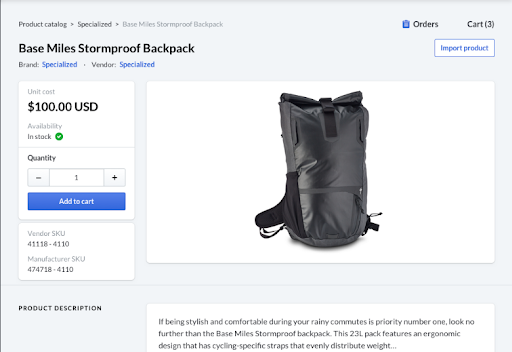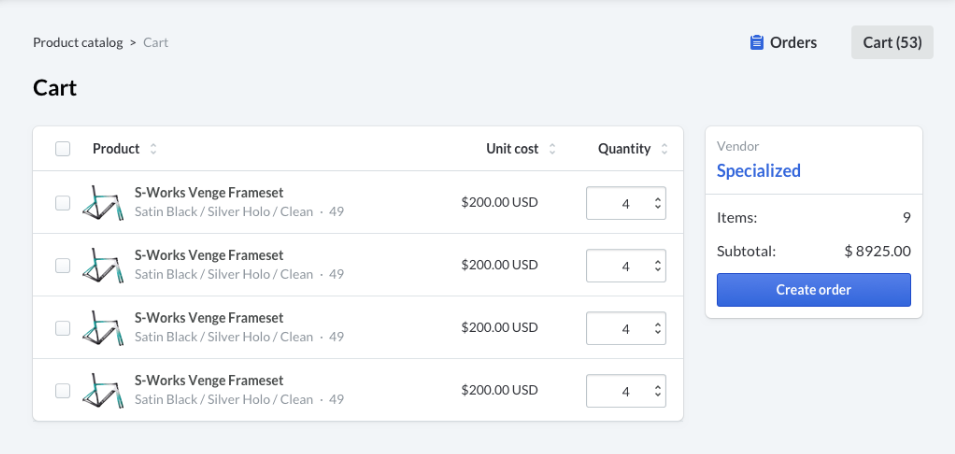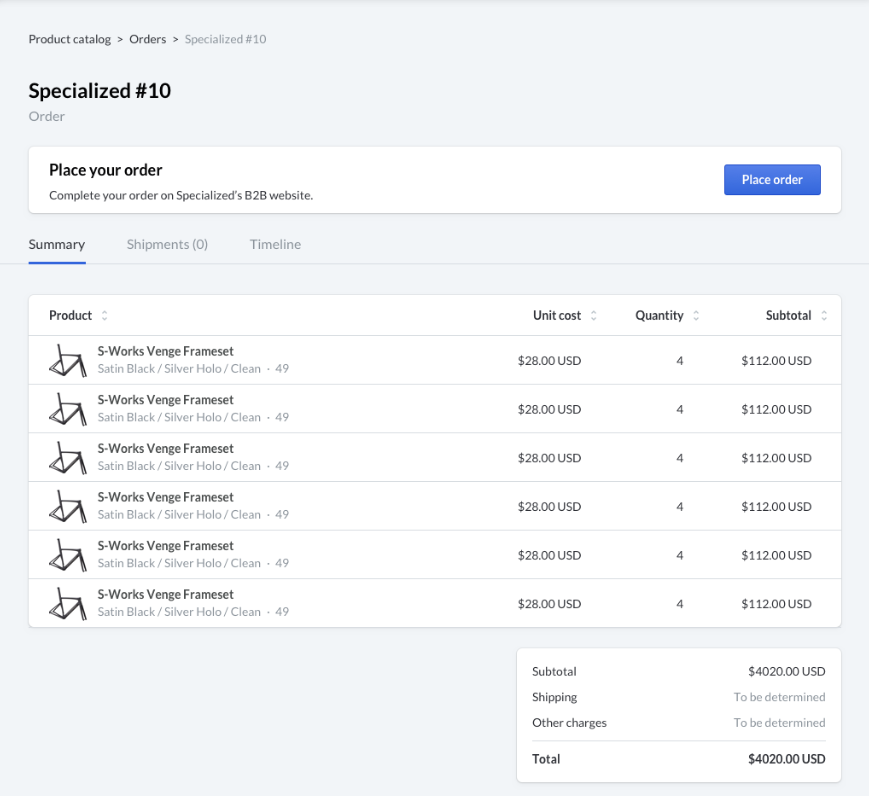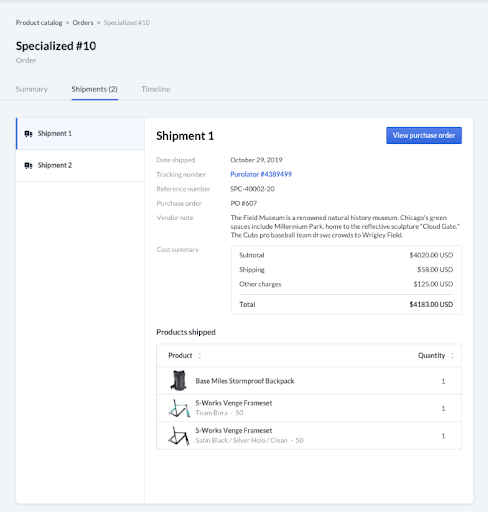Retailers Ordering Experience
How a Retailer will Order from your Brand within Lightspeed
1. A Retailer connects Lightspeed to their account with your brand
Retailers are unable to see product costs or order from your catalog of items before connecting Lightspeed to their account with your brand. Lightspeed will hide these from them in the user interface and instead ask the Retailer to “Connect to Vendor” (See Figure 1.0).

Figure 1.0: Connection button shown to Retailers on the product page. Product costs and the ability to order are hidden until after the connection is approved by the brand.
Whats Visible
Retailers are unable to see your product costs or order until they have been approved to connect to your Brand. Once approved, they will have access to that data.
A Retailer has two places inside Lightspeed where they can connect their account with you.
- Product page (See figure 1.0)
- Vendor page
Clicking the “Connect to vendor” button will prompt them to see Figure 1.1:
- Provide their account number with your brand
- Provide a contact email (so you can email them if necessary to confirm details)
- Agree to your terms of service
(See This Setup Page for instructions to set up your Terms of Service)

Figure 1.1: Connection submission form inside Lightspeed. All fields are “required”, including agreeing to your terms of service. The store name is pulled directly from Lightspeed and cannot be edited by the Retailer.
While their connection is pending your approval, they will continue to be unable to view your costs or order from your catalog inside Lightspeed. They will also see a message that explains this (see Figure 1.2).

Figure 1.2: The message shown to Retailers while they await approval to purchase from your catalog inside Lightspeed.
2. A Retailer creates an Order in Lightspeed
A Retailer chooses the items and quantities they want to purchase from you.
Retailers can browse your catalog and add items to their cart (See Figure 2.0). The cart is represented in our API as an order in the orderOpen state, only Retailers can get and update their carts.

Figure 2.0: The product page as shown to Retailers after they have been approved to purchase from you. Unit cost and “add to cart” are now displayed. Note: “Availability” is an upcoming feature and not available yet.
Retailer submits the order to you
A Retailer can add items to their cart and update the quantities they wish to order. When they are done, they can submit this order to you by “creating the order” (see Figure 2.1). This creates an order in the orderSubmitted state and is ready for you to retrieve.
(See how this will look for you HERE)

Figure 2.1: The cart page where Retailers can manage which items they currently want to buy from you. The cart is an order in the orderOpen state.
3. A Retailer completes the order in your B2B
After submitting the order within Lightspeed, the Retailer is redirected to a summary of their order. On this order summary page, they are prompted to complete the purchasing process within your brand’s B2B portal (see Figure 3.0).

Figure 3.0: The order summary page where Retailers are prompted to complete the order in your B2B portal. Lightspeed requires your B2B login URL to be set up in the Lightspeed Supplier Backoffice in order to successfully redirect Retailers to your B2B website.
We expect most Retailers to immediately click through to your B2B portal to complete the purchasing process. To create the best possible purchasing experience, please ensure the cart is created by that time on your B2B portal for them to complete.
Verifying Details
Visiting your B2B portal is necessary to verify availability of items, Retailer specific prices, discounts and promotions, shipping details, and payment details.
While a Retailer completes their order within your brand’s B2B portal, the following can change:
- Add/remove quantities
- Update unit cost per product
- Add shipping cost
- Add other cost
- Add dollar or percentage discount
4. A Retailer Receives a Shipment of Items
After you create a shipment in the Backoffice Lightspeed, the Retailer will be notified through their point of sale (see Figure 4.0). Opening the shipment in Lightspeed, the Retailer will have a summary of the shipment details including the items, quantities and shipment tracking number (see Figure 4.1). This allows them to start preparing to receive the items and track the location of the package as it arrives.
Figure 4.0: The Retailer is notified of shipments you created when viewing the order. A red dot above the shipments tab is displayed.

Figure 4.1: The Retailer can view the details of each shipment within the shipments tab. From here, the Retailer can click the “View purchase order” button to receive the shipment when the package arrives.
When the shipment company drops off the packages, the Retailer can navigate to their in-transit shipments in Lightspeed and begin the receiving process.
How Lightspeed Handles Multiple Shipments
Lightspeed creates a Purchase Order for each shipment which allows the Retailer to receive and pay for individual shipments. This ensures their accounting remains in balance throughout the fulfillment of the entire order (which may involve multiple shipments over several months).
Note: Lightspeed also creates all items received on the shipment that have not already been created in Lightspeed. The information you provide in your product catalog is imported directly to their point of sale.
The Retailer opens the box and inspects the items and quantities received by either manually counting them or scanning the item barcodes. After reviewing all the items in the shipment the Retailer can assess whether anything is missing and close the purchase order (see Figure 4.2).

Figure 4.2: Each shipment has a corresponding purchase order within the Retailer’s point of sale. This allows them to receive each shipment and balance their accounting properly. On this screen, the Retailer can either manually or using a barcode scanner receive the items within each shipment package and add the items to their inventory.
Receiving shipments will continue until all products and quantities for that order are either shipped or cancelled by the Vendor. An order will remain open within the Retailer’s point of sale if any items have not been received. At that point, the Retailer may contact you to understand the state of their order and items which have not been received.
Updated about 6 years ago
